The Diverging Paths of Russia and China: A Tale of Oil and Green Energy
In a significant shift in global trade dynamics, Russia’s oil exports to China surged by 24% in 2023 compared to the previous year. The Sila Sibiri pipeline, also known as the "Power of Siberia," has been operating at full capacity to meet the rising demand from Beijing. This increase has offered a temporary lifeline to the Russian economy, vital for its financial stability amid international sanctions and geopolitical tensions.
However, this boom may be short-lived. While Russia leans heavily on fossil fuel exports, its largest buyer, China, is rapidly transitioning toward renewable energy sources. This divergence in energy strategies could spell trouble for Moscow’s long-term economic plans.
A Pivot to the East
Following escalating sanctions from Western nations, Russia has redirected its fuel exports towards the East, with China emerging as the primary customer. In 2023, Russia exported 107 million tonnes of crude oil to China, accompanied by a substantial increase in gas exports. These sales represented a total of 8 million tonnes of natural gas liquids.
Yet, the explosive growth in this trade relationship is limited by infrastructural capacities. The Sila Sibiri pipeline is already functioning at its limits, and Chinese financial support for expanding this energy channel remains elusive. Recent endeavors by President Vladimir Putin to secure backing for the Sila Sibiri-2 pipeline during his recent visit to Beijing did not yield the desired results, indicating a future bottleneck in Russia’s export capacities.
Beijing’s Green Agenda
While Russia’s energy plan hinges on fossil fuel exports, China’s energy strategy is on a different trajectory. China is actively pursuing a green transformation with aggressive investments in renewable energy. According to Carbon Brief, China’s renewable energy sector has contributed a staggering 11.4 trillion yuan ($1.6 trillion) to its economy in 2023 alone, with investments growing at an estimated 40% of GDP, the highest among all economic sectors.
This green shift encompasses various energy types, including wind, solar, nuclear, and the expansion of power grids and electric vehicle infrastructure. China currently holds 43% of global solar power potential and wind turbine capacities, far outpacing Russia, whose contribution stands at a mere 0.5% of China’s renewable energy output.
The Dual Approach
Interestingly, while accelerating its green agenda, China has not entirely abandoned traditional energy sources. In 2023, China constructed 95% of the world’s new coal facilities and continued to rely on fossil fuels for 53% of its energy needs. However, its long-term goal is a radical green transformation by 2030. For now, fossil fuels are a stopgap measure, leveraged to ensure energy security and economic stability during the transition phase.
Implications for Russia
The rapid greening of the Chinese economy poses a significant risk to the future of Russia’s fossil fuel-dependent economy. Gas currently accounts for just 3% of China’s energy production, used predominantly for industrial purposes. Oil, on the other hand, is primarily employed in transportation rather than energy production. The shift to electric vehicles in China has been nothing short of remarkable; in 2023, over 25% of new cars sold in China were electric, a substantial increase from just 6% in 2020.
This sectoral shift indicates that China’s dependency on fossil fuels from Russia is likely to diminish over the next decade. As Beijing continues to position itself as a global leader in green energy, Moscow may find it increasingly difficult to sustain its current export levels, thereby exacerbating the economic challenges posed by Western sanctions.
Conclusion
Russia’s recent surge in oil exports to China has provided a vital economic cushion. However, China’s relentless push toward renewable energy sources suggests that this boom might be fleeting. As China advances towards a greener future, Russia’s reliance on fossil fuel exports could lead to an economic impasse, highlighting the diverging paths of these two nations. For more information on the Sila Sibiri pipeline and its significance, visit the official Gazprom website.
This article provides a comprehensive overview of the evolving trade relationship between Russia and China, contextualized within the broader scope of recent historical and economic developments.
